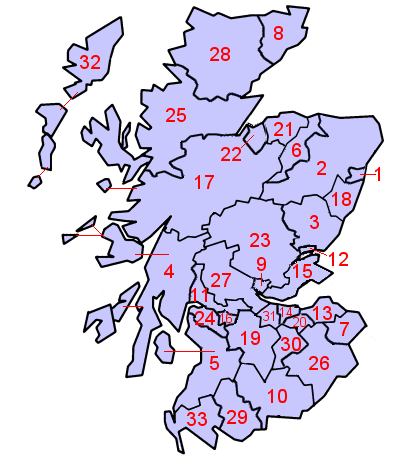|
Annandale And Eskdale
Annandale and Eskdale is a committee area in Dumfries and Galloway, Scotland. It covers the areas of Annandale and Eskdale, the straths of the River Annan and the River Esk respectively. From 1975 until 1996 it was a local government district. History The two straths of Eskdale and Annandale had each been medieval provinces of Scotland, with Annandale being a stewartry and Eskdale a lordship. The provinces were gradually eclipsed in importance by the shires as the main unit of local administration, with Annandale and Eskdale coming to be seen as two of the three divisions of Dumfriesshire, the other being Nithsdale. Dumfriesshire was administered by commissioners of supply from 1667 and by a county council from 1890. The hereditary jurisdictions of Eskdale and Annandale ended with the Heritable Jurisdictions (Scotland) Act 1746. A local government district called Annandale and Eskdale was created on 16 May 1975 under the Local Government (Scotland) Act 1973, which established ... [...More Info...] [...Related Items...] OR: [Wikipedia] [Google] [Baidu] |
Annan, Dumfries And Galloway
Annan ( ; gd, Inbhir Anainn) is a town and former royal burgh in Dumfries and Galloway, south-west Scotland. Historically part of Dumfriesshire, its public buildings include Annan Academy, of which the writer Thomas Carlyle was a pupil, and a Georgian building now known as "Bridge House". Annan also features a Historic Resources Centre. In Port Street, some of the windows remain blocked up to avoid paying the window tax. Each year on the first Saturday in July, Annan celebrates the Royal Charter and the boundaries of the Royal Burgh are confirmed when a mounted cavalcade undertakes the Riding of the Marches. Entertainment includes a procession, sports, field displays and massed pipe bands. Annan's in America first migrated to New York and Virginia. Annandale Virginia is an early settlement which celebrates The Scottish Games annually. Geography Annan stands on the River Annan—from which it is named—nearly from its mouth, accessible to vessels of 60 tons as far as ... [...More Info...] [...Related Items...] OR: [Wikipedia] [Google] [Baidu] |
Commissioner Of Supply
Commissioners of Supply were local administrative bodies in Scotland from 1667 to 1930. Originally established in each sheriffdom to collect tax, they later took on much of the responsibility for the local government of the counties of Scotland. In 1890 they ceded most of their duties to the county councils created by the Local Government (Scotland) Act 1889. They were finally abolished in 1930. Creation The Parliament of Scotland passed legislation creating Commissioners of Supply for each of the shires or sheriffdoms in 1667. The act specified that the commissioners for each sheriffdom should consist partly of '' ex officio'' members: all privy councillors and senators of the College of Justice "within the severall respective shyres wher any part of ther lands and estates doeth ly", and partly of nominated members: a number of named prominent landowners in each shire.The sheriffdoms listed were Edinburgh (i.e. Midlothian), Hadingtoun (i.e. East Lothian), Berwick, Roxburgh, ... [...More Info...] [...Related Items...] OR: [Wikipedia] [Google] [Baidu] |
Lord-lieutenant
A lord-lieutenant ( ) is the British monarch's personal representative in each lieutenancy area of the United Kingdom. Historically, each lieutenant was responsible for organising the county's militia. In 1871, the lieutenant's responsibility over the local militia was removed. However, it was not until 1921 that they formally lost the right to call upon able-bodied men to fight when needed. Lord-lieutenant is now an honorary titular position usually awarded to a retired notable person in the county. Origins England and Wales Lieutenants were first appointed to a number of Historic counties of England, English counties by King Henry VIII in the 1540s, when the military functions of the sheriffs were handed over to them. Each lieutenant raised and was responsible for the efficiency of the local militia units of his county, and afterwards of the yeomanry and volunteers. He was commander of these forces, whose officers he appointed. These commissions were originally of tempora ... [...More Info...] [...Related Items...] OR: [Wikipedia] [Google] [Baidu] |
Lieutenancy Areas Of Scotland
The lieutenancy areas of Scotland are the areas used for the ceremonial lord-lieutenants, the monarch's representatives, in Scotland. The lord-lieutenants' titles chosen by the monarch and his legal advisers are mainly based on placenames of the traditional counties of Scotland. In 1794 permanent lieutenancies were established by Royal Warrant. By the Militia Act 1797 (37 Geo.3, C.103), the lieutenants appointed "for the Counties, Stewartries, Cities, and Places" were given powers to raise and command County Militia Units. While in their lieutenancies, lord lieutenants are among the few individuals in Scotland officially permitted to fly a banner of the Royal Arms of Scotland, the "Lion Rampant" as it is more commonly known. Lieutenancy areas are different from the current local government council areas and their committee areas. They also differ from other subdivisions of Scotland including sheriffdoms and former regions and districts. The Lord Provosts of Aberdeen, Dunde ... [...More Info...] [...Related Items...] OR: [Wikipedia] [Google] [Baidu] |


